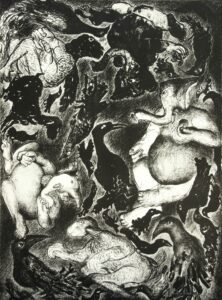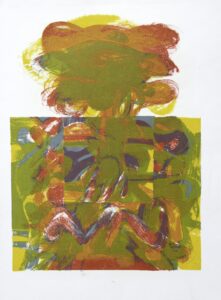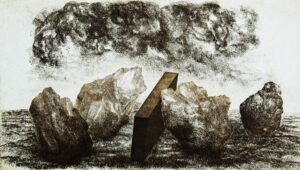
Devraj Dakoji/ A lithograph from the Pranamu series (supplied)
The ongoing exhibition at Bengaluru’s National Gallery of Modern Art (NGMA) is a tribute to India’s legendary master printmaker Devraj Dakoji’s life’s work.
Curated by Darshan Kumar YU and along with Amrutha R and Subarna Patro, the retrospective features over 600 of Dakoji’s works, which Darshan says was whittled down from 3000 plus of his works.
At this month-long exhibition, one can find some of his popular works from the ‘Pranamu Series’ and ‘Rock Series’ besides ‘On the LIRR’ series, where he used ticket stubs from the Long Island Rail Road in North America as canvases.
“This exhibition is not really showing my new work. It mainly shows how I started my career. My early works were mostly water colours. I did a lot of sketching and used to go out in nature to paint landscapes. Those were the kind of work I did before attending art college. So I think this exhibition will let people see how I got involved in printmaking and how I have collaborated with different artists,” says the 79-year-old artist, who is the only Master Printmaker in India.
Presently in Bengaluru as part of this exhibition, Devraj Dakoji speaks to South First about what he expects people would take away from his work and the current state of printmaking in India.
Born to a family of Ayurveda practitioners, picking herbs for his father every morning before going to school proved to be a lasting influence in Dakoji’s life and art.
He says, “Even though I helped them out, my family never expected me to follow that path. They had seen my drawings and wanted me to enrol in a fine arts school.”

Medium Lithograph on Paper 70 cm x 57 cm from the Pranamu Series (Supplied)
Looking back at his earlier works, Dakoji gets candid, “During my early days as an artist, the basic idea was to capture the things that I see on paper. That’s how you start. Later on, I started seeing other artists’ work and their exhibitions, the different things that they did and that inspired me.”
He recollects, “This one time, I saw the work of a German artist. She had done black and white drawings in lithographs and woodcuts. It was about how people suffered during the World War II. She depicted the pain in those black-and-white drawings. That really inspired me. I liked the way she expressed it. I had no idea about graphics before. But I realised I wanted to study it after seeing that. Seeing that exhibition gave me a stronger feeling about printmaking.”
Nature as a theme informs most of Dakoji’s artworks. One sees a lot of landscapes and animals in them. People, not so much.
Dakoji reminisces the time when he travelled to San Diego in 1985. To his surprise, he was woken up one day by the sound of peacocks. While that reminded him of home, it also led him to have an inner awakening.

Title: Organic forms, Medium Colour Lithograph on Paper (Supplied)
“I became acutely aware that life moves from place to place, back and forth across the globe. Wherever I have travelled I feel that nature calls out to me,” he says.
And that became the inspiration for him to explore ‘Pranamu’, his series of etchings and lithographs, veering towards abstraction.
One also finds hints of Ganesha in his artworks, which he says are also an extension of nature.
“You know the legend is that Parvathi made a sculpture and prayed to Brahma to give life to it. And that’s how Ganesha was created. For me, everything, including mythology, comes down to nature and life,” he adds.
Interestingly, one of his first bodies of work, the ‘Stone Series’, depicts the primordial boulders that dominated his hometown, Hyderabad.
There are grand rock formations that you see on both sides when you drive to Hyderabad. Their uneven contours sometimes form shapes that are illusive.

Medium Etching & Aquatint on Paper From the Rock Series (Supplied)
“During nighttime, you don’t see the rocks, but you feel as if they are people sitting and talking to each other. That idea inspired me and I started observing rocks. During that period, I went to London where I came across exhibitions and research around the rocks outside Oxford, similar ones in France, Peru etc. That further gave me the confidence to pursue the series,” shares Dakoji. He then began work on his ‘Rocks Series’ in the mid-70s and continued for the next 10 years. .
His latest series, ‘Wheel of the Life’, he says, is based on Buddhism. In the series, he explores the cycle of life that continues despite man’s destructive interactions with nature, causing life forms to adapt ensuring their own survival.
Talking of the state of printmaking in India, Dakoji says more exposure and awareness are required.
“Back in my day, colleges didn’t have undergraduate and graduate programs in printmaking. They only had it as a subsidiary subject. Now, several colleges have full-fledged departments where one can get your degree and Masters in printmaking. So there are a lot of artists and students working very hard but they don’t have a platform. That’s the issue. In India, there’s no awareness of printmaking even now. For that, we need a proper platform, and dedicated galleries that can give more exposure,” he details.
Students must look beyond the curriculum as well.
“I see a lot of students involved in printmaking. They are very hardworking. But the problem they are going to face is the availability of materials like printing inks and chemicals. They are scarce in India. We have to learn to find the right materials. I tell the students to research materials the way science students research. We need more ideas and innovations so we can go to manufacturers and find ways to tackle the unavailability,” signs off Dakoji.
The exhibition is on till 10 October.

May 15, 2024

May 14, 2024

May 14, 2024

May 14, 2024

May 13, 2024

May 13, 2024